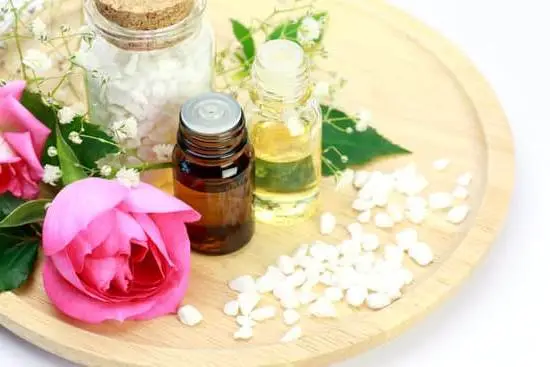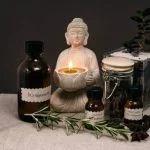Candle aromatherapy is a popular and effective way to create a soothing and relaxing environment in your home. By harnessing the power of essential oils, you can enhance your mental, emotional, and physical well-being. In this article, we will explore the benefits of candle aromatherapy and how you can make your own aromatherapy candles at home.
Aromatherapy has been used for centuries to promote relaxation, reduce stress, and improve overall health. When combined with the warm glow of a flickering candle, it creates a tranquil atmosphere that can help calm the mind and uplift the spirit. The aromatic scents released by the candles can have a profound effect on our mood and emotions, allowing us to unwind after a long day or set the stage for a serene meditation practice.
To create an aromatherapy candle, essential oils are blended with wax and then burned to release their therapeutic fragrances. Essential oils are derived from plants and contain the essence of their natural scent and healing properties. Each oil has its own unique aroma and potential benefits, such as relaxation, stress relief, improved sleep quality, or enhanced focus.
Choosing the right wax is important when making aromatherapy candles. Soy or beeswax are ideal choices as they burn cleanly without releasing harmful toxins into the air. Additionally, these waxes have a lower melting point than paraffin wax, which allows the essential oils to disperse more effectively throughout the room.
In the following sections of this article, we will delve deeper into understanding essential oils, selecting the perfect candle wax container, blending oils for specific purposes, providing step-by-step instructions for making your own aromatherapy candles at home, discussing safety measures for handling and storing these candles properly, as well as tips and tricks to enhance your aromatherapy experience.
By learning how to make candle aromatherapy at home, you can personalize your scents according to your preferences while reaping the benefits of relaxation, stress relief, and overall well-being. So let’s dive in and explore the wonderful world of candle aromatherapy together.
Understanding the Basics
Essential oils play a crucial role in candle aromatherapy, as they are responsible for creating the desired scent and therapeutic benefits. Understanding the basics of essential oils and their properties is essential for successfully making your own aromatherapy candles.
Essential oils are highly concentrated plant extracts that capture the aromatic compounds of various plants. These oils are derived from different parts of plants such as flowers, leaves, bark, and roots through processes like distillation or cold pressing. Each essential oil has its unique scent profile and therapeutic properties.
When it comes to candle aromatherapy, certain essential oils are commonly used for specific purposes. For example, lavender essential oil is known for its relaxing and calming properties, making it perfect for a soothing bedtime candle. On the other hand, lemon or citrus essential oils can uplift mood and promote focus, making them suitable for an energizing candle to use during work or study sessions.
In addition to their scent profiles, essential oils also have various therapeutic benefits. Some common benefits include stress relief, relaxation, improved sleep quality, enhanced focus and concentration, mood enhancement, and even relief from certain health conditions like headaches or congestion. It is important to research and understand these properties before blending different essential oils together to ensure you achieve your desired results.
| Essential Oil | Scent Profile | Therapeutic Properties |
|---|---|---|
| Lavender | Floral, herbaceous | Relaxing, calming |
| Lemon | Citrusy | Uplifting, energizing |
| Eucalyptus | Minty, woody | Decongestant, invigorating |
| Patchouli | Earthy, musky | Grounding, aphrodisiac |
| Peppermint | Minty, refreshing | Cooling, clarity-enhancing |
Choosing the Right Wax
When it comes to making homemade aromatherapy candles, selecting the right wax is crucial to ensure a high-quality and effective product. Soy and beeswax are two popular options in candle-making for their unique properties that enhance the benefits of candle aromatherapy.
The Benefits of Soy Wax
Soy wax is derived from soybeans, making it a natural and eco-friendly choice for candle-making. One of the main advantages of using soy wax is its clean burn. Unlike paraffin wax, which is commonly used in commercial candles, soy wax does not release harmful toxins or soot when burned. This means that you can enjoy your aromatherapy candle without worrying about any adverse effects on your health or the environment.
Soy wax also has excellent scent retention properties. It allows essential oils to blend well with the wax, resulting in a strong and long-lasting fragrance when the candle is lit. Additionally, soy wax burns at a lower temperature compared to other waxes, which means that your aromatherapy candle will have a longer burn time.
The Benefits of Beeswax
Beeswax is another natural option that offers its own set of benefits for aromatherapy candles. Beeswax has a subtle honey-like scent that adds a touch of sweetness to your relaxing space. Similar to soy wax, beeswax also burns cleanly without releasing toxins or soot into the air.
One notable advantage of beeswax is its ability to release negative ions when burned. These negative ions can help purify the air by neutralizing pollutants such as dust, mold spores, and allergens. As a result, burning beeswax candles can enhance the air quality in your living space while creating an ambiance conducive to relaxation and well-being.
Selecting the Perfect Candle Wax
When it comes to making your own aromatherapy candles, selecting the right candle wax is crucial. Not only does it determine how well your candle will burn, but it also affects the overall scent and aesthetic appeal of your handmade creation.
One popular choice for aromatherapy candle wax is soy wax. Soy wax is made from soybean oil and has a lower melting point compared to other waxes, which means that it burns evenly and slowly, allowing you to enjoy the aroma for longer periods of time.
Another excellent option for aromatherapy candles is beeswax. Beeswax is a natural wax made by bees, known for its clean-burning properties. It has a warm glow and a lovely honey-like scent that adds to the overall ambiance of your candles. Beeswax candles also have air-purifying qualities, emitting negative ions that help neutralize pollutants in the air.
Once you have chosen your desired wax, it’s important to find the ideal container for your aromatherapy candle. The container will not only hold the melted wax but also contribute to the visual appeal of your final product. Glass containers are a popular choice as they allow you to see the melted wax and add an elegant touch to any space. Mason jars are another great option as they give off a cozy and rustic vibe.
To ensure that your container is suitable for holding hot wax, make sure it is heat-resistant and can withstand high temperatures without cracking or breaking. Remember to choose a container with enough depth to accommodate your desired amount of melted wax while leaving additional space at the top for proper burning.
In summary, selecting the perfect candle wax and container plays a vital role in creating an enjoyable aromatherapy experience. Whether you opt for soy wax or beeswax, both offer unique benefits such as slow-burning and air-purifying properties.
Additionally, choosing the right container provides both functionality and aesthetic appeal to your homemade aromatherapy candles. Take your time in selecting these elements, and you’ll be on your way to creating beautiful and effective candles for your relaxation and well-being.
Crafting a Relaxing Scent
When it comes to candle aromatherapy, the scent is an essential aspect that can greatly enhance the experience. By carefully selecting and blending essential oils, you can create a unique and relaxing fragrance that soothes your senses. In this section, we will explore the art of blending essential oils for aromatherapy candles.
To begin, it is important to understand that different essential oils have distinct properties and benefits. Some oils are known for their calming effects, while others are energizing or uplifting. By choosing the right combination of oils, you can create a scent that suits your specific needs and preferences.
When blending essential oils for aromatherapy candles, it is recommended to use a maximum of three to four oils. This allows the scents to complement each other without overpowering the overall fragrance. Start by selecting a base note oil, which forms the foundation of your blend. Common base note oils include lavender, patchouli, and sandalwood.
Next, choose middle note oils, which add depth and balance to the fragrance. Popular middle note oils include geranium, ylang-ylang, and clary sage. Finally, select top note oils which provide the initial impression of the scent and quickly evaporate. Citrus oils like lemon and bergamot are commonly used as top notes.
Remember to consider the potential therapeutic benefits of each oil when blending for aromatherapy purposes. For relaxation and stress relief, lavender and chamomile are excellent choices. If you need an energy boost or want to uplift your mood, consider using citrusy scents like grapefruit or orange.
By experimenting with different combinations of essential oils and adjusting their ratios, you can create personalized blends that promote relaxation or invigoration based on your preferences. Keep in mind that everyone’s sense of smell is unique, so what may be pleasing to one person might not be as appealing to another. Trust your intuition and find the scents that bring you the most joy and relaxation.
| Essential Oils | Therapeutic Benefits |
|---|---|
| Lavender, Bergamot, Patchouli | Promotes relaxation and restful sleep |
| Eucalyptus, Peppermint, Rosemary | Clears the mind and promotes focus |
| Lemon, Orange, Grapefruit | Uplifts the mood and boosts energy |
Blending essential oils for aromatherapy candles allows you to create a personalized scent that enhances your well-being. Remember to start with small amounts when experimenting with different oils until you find the perfect blend. With practice and creativity, you can craft unique aromatherapy candles that provide both an enchanting fragrance and therapeutic benefits.
Step-by-Step Guide
Making your own aromatherapy candle can be a fun and rewarding experience. Not only will you have the opportunity to customize the scent to your liking, but you will also be able to enjoy the therapeutic benefits of essential oils. In this step-by-step guide, we will walk you through the process of creating your own aromatherapy candle.
Gather Your Materials
Before you begin, make sure you have all the necessary materials on hand. You will need:
- Candle wax (preferably soy or beeswax)
- Essential oils of your choice
- Candle wicks
- Heat-resistant container or mold
- Double boiler or a heat-safe container and a pot
- Thermometer
- Stirring utensil (such as a wooden spoon)
- Optional: dye chips or crayons for color
Melt the Wax
Start by melting the candle wax in a double boiler or heat-safe container placed in a pot with water. It’s important to melt the wax slowly and evenly to prevent any clumps or overheating. Use a thermometer to monitor the temperature and ensure it does not exceed 180 degrees Fahrenheit.
Add Essential Oils
Once the wax has melted completely, remove it from heat and let it cool slightly. It should be around 140 degrees Fahrenheit before adding essential oils. Add approximately one ounce of essential oil per pound of wax for a strong scent. You can adjust this ratio based on personal preference.
After adding the essential oils, gently stir the mixture to evenly distribute them throughout the wax. Be sure not to overmix as this can cause air bubbles in your candle.
Now that you have followed these initial steps, continue with pouring the wax into your chosen container and inserting a wick properly before allowing it to cool and solidify. Refer to our next section, Safety Measures: Proper Handling and Storage of Aromatherapy Candles, for detailed instructions on the final steps of making your own aromatherapy candle. With this step-by-step guide, you’ll be able to create your own personalized candle and enjoy the benefits of homemade candle aromatherapy.
Safety Measures
Proper handling and storage of aromatherapy candles are crucial to ensure your safety and the longevity of your candles. Here are some important safety measures to keep in mind:
Never Leave a Burning Candle Unattended
It’s essential to never leave a burning candle unattended for your safety and to prevent any potential accidents. Make sure you extinguish the candle before leaving the room or going to bed.
Keep Candles Away From Flammable Materials
To avoid fires, always place your aromatherapy candles on stable, heat-resistant surfaces away from any flammable materials such as curtains, paper, or clothing. Ensure there is enough space around the candle to prevent accidental contact.
Trim the Wick Before Each Use
Trimming the wick before lighting your candle helps control the size of the flame and prevents excessive soot or smoke. Maintain the wick length at about 1/4 inch for optimal performance and safety.
Burn Candles in a Well-Ventilated Area
Adequate ventilation is essential when burning candles, especially if you’re scenting a large space. Ensure there is proper airflow in the room to prevent excessive buildup of smoke or soot.
Store Candles Properly
When not in use, store your aromatherapy candles in a cool, dry place away from direct sunlight and extreme temperatures. This will help preserve their fragrance and overall quality.
Keep Out of Reach of Children and Pets
Candles should always be placed out of reach of children and pets to avoid accidental burns or fire hazards. Remember to place them on higher surfaces where they won’t be easily knocked over.
By following these safety measures, you can enjoy your aromatherapy candles with peace of mind knowing that you are taking the necessary precautions. Always prioritize safety and be vigilant when handling and storing your candles.
Tips and Tricks
In addition to creating your own aromatherapy candles using essential oils, there are a few additional techniques you can incorporate to further enhance the benefits and experience of candle aromatherapy. These simple tips and tricks can help create a more soothing atmosphere and promote relaxation.
One technique to enhance the aromatherapy experience is by using color therapy. Color has been known to have a significant impact on our mood and emotions, and incorporating specific colors into your candles can help support the desired effect of your chosen essential oils.
For example, if you are looking to create a calming ambiance, consider using blue or purple colored candles, as these colors are associated with tranquility and relaxation. On the other hand, if you want to uplift your mood or add energy to a space, yellow or orange colored candles will be more suitable.
Another technique that can enhance the overall aromatherapy experience is by incorporating candle holders or diffusers into your setup. These accessories not only provide an aesthetically pleasing look but also help distribute the aroma more effectively throughout the room.
Candle holders made from materials such as glass or ceramic can diffuse the scent gently and evenly while also adding a touch of elegance to your space. Diffusers have small openings or holes that allow for controlled air circulation, perfect for enjoying the therapeutic benefits of aromatherapy.
Lastly, considering the placement of your homemade aromatherapy candle can make a difference in its effectiveness. Placing candles strategically in areas where you spend most of your time or where you want to create a relaxing atmosphere can maximize their impact. For example, placing candles near your bed when it’s time to wind down for sleep or in your living room during moments of relaxation can help set the mood and promote calmness.
By implementing these additional techniques into your candle aromatherapy routine, you can further elevate the benefits and experience of this holistic practice. Discovering how various techniques work best for you will allow you to personalize your aromatherapy experience and create a soothing ambiance that suits your needs and preferences.
Conclusion
In conclusion, making your own candle aromatherapy can be a rewarding and beneficial experience. By understanding the basics of essential oils and their properties, choosing the right wax, and selecting the perfect container, you can craft a truly relaxing scent that suits your preferences and needs.
Following a step-by-step guide will help you create your own aromatherapy candle, allowing you to enjoy the benefits of this practice in the comfort of your own home. It is important to remember safety measures when handling and storing aromatherapy candles to ensure that you have a safe and enjoyable experience.
Additionally, there are various tips and tricks that can enhance your aromatherapy experience even further. Experimenting with different blends of essential oils, using additional techniques such as meditation or breathing exercises, and adjusting the ambiance of your space can all contribute to a more immersive and transformative experience.
By taking the time to create homemade candle aromatherapy, you not only gain the satisfaction of crafting something with your own hands but also reap the numerous benefits this practice has to offer. From relaxation and stress relief to improved mood and overall well-being, homemade candle aromatherapy provides a holistic approach to self-care. So go ahead, indulge in this sensory journey and let the soothing scents envelop you in tranquility.
Frequently Asked Questions
What Makes a Candle an Aromatherapy Candle?
Aromatherapy candles are specifically designed to provide a therapeutic and relaxing experience through the use of essential oils. These candles are made by blending essential oils with other ingredients, such as soy or beeswax, to create a scented candle that can be burned to release the fragrance and therapeutic benefits of the oils into the air.
The specific selection and combination of essential oils used in aromatherapy candles are carefully chosen for their desired effects, such as promoting relaxation, reducing stress, or improving mood. Aromatherapy candles often have a subtle scent and are used during practices like meditation, yoga, or simply to create a calming ambiance in a room.
Can I Add Essential Oil to Candle?
Yes, it is possible to add essential oil to a candle. However, it is important to take certain precautions when doing so. First, ensure that you are using a container or vessel specifically designed for candle making and burning.
Adding essential oil directly into an already-made candle may cause uneven burning or compromise the structural integrity of the original candle. To add essential oil to your own candle, melt some wax (such as soy or beeswax) in a double boiler and then mix in your desired quantity of essential oil while the wax is still melted but not excessively hot. Stir well to ensure even distribution before pouring the mixture into your container or mold and allowing it to cool and solidify completely.
How Do You Make Your Own Candle Scents?
Making your own candle scents can be an enjoyable and creative process. There are several methods you can use to make your own unique candle scents at home. One popular method is blending different types of essential oils together to create custom fragrances that suit your personal preferences. Start by selecting complementary scents that you enjoy individually, taking note of their characteristics – whether they are floral, citrusy, woody, or spicy – and experiment with different ratios until you achieve your desired scent profile.
You can also consider adding natural botanicals like dried flowers or herbs to create interesting visual and aromatic elements in your candle. Another option is to use fragrance oils, which are synthetic fragrances specifically formulated for candle making, as these often provide a wider range of scents to choose from. Whichever method you choose, remember to consider the safety guidelines and proper proportions for scenting candles to ensure optimal results and prevent any potential hazards.

Are you looking for a natural way to improve your health and wellbeing?
If so, aromatherapy may be the answer for you.





